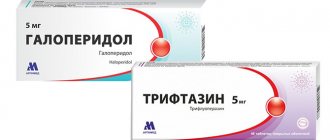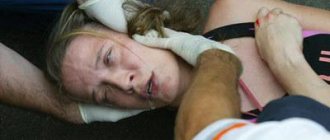Schizoaffective disorder is a pathology of the schizophrenia spectrum. And although some believe that the course of the pathology is easier and disability is much less than in schizophrenics, one cannot say that schizoaffective disorder is easier than anything, this is wrong, there is simply a peculiarity in the ability not to form a defect.
Schizoaffective disorder, due to a special approach to diagnosis, is difficult to identify, but has approved criteria and methods of relief. The symptoms of this disorder are quite striking, but somewhat vague, which further complicates the conditions of working with schizoaffective patients.
Types of Schizoaffective Disorder
Schizoaffective disorder is a relatively recent diagnosis in psychiatry. Previously, it was a form of schizophrenia, manifested in mental-affective disorders with cyclical mood changes. Therefore, senior doctors are still inclined to talk about cycloid schizophrenia and are not always happy with the classification. Still, there are big differences between schizophrenia with neurochanges and schizoaffective disorder.
The etiology, the root cause of schizoaffective disorder is very vague and has not been thoroughly studied, and taking into account all the circumstances of the development of the pathology, we can say that there is a lot of controversy about this disease. The boundaries of schizoaffective disorder are so blurred that there are many ideas about the origin of this pathology. And since the symptoms are reminiscent of affective, mood and schizophrenic disorders, it is believed that these two pathologies are combined in schizoaffective disorder. Sometimes this pathology is introduced in a heterogeneous disease that contains both diseases.
Schizoaffective disorder has its own specific causes, which are often difficult to identify initially. The genetic factor plays a significant role in the formation of this disorder; if someone in the family had a mental illness, then the child is at risk for the occurrence of this. The psycho-emotional state of an individual, as well as the entire surrounding society, can be a strong provocateur of such pathologies. Various negative events can become especially stressful. Depression and emotional instability are also considered provocateurs.
Schizoaffective personality disorder is often formed as a result of interpersonal discord, as well as personal dissatisfaction. Schizoaffective personality disorder develops at a very young age, from adolescence to adulthood; the onset of the disease rarely occurs later than thirty. This disorder is more common in women.
Schizoaffective personality disorder is more characteristic of a specific personality type. Those most susceptible to it are those who are anancastic or anxious, as well as schizoid people. The disorder can be manifested by bankruptcy or failure in certain aspects of life. Misfortunes and psychological trauma can become provocateurs.
Schizoaffective disorder ICD 10 has the number 25. According to the classification, it is divided into a group of types. Schizoaffective disorder according to ICD 10 can be manic or the opposite type - depressive. Also in the classification there is a mixed disorder in manifestations, with several types of symptoms. This pathology may also have separate types, such as unspecified.
Schizoaffective psychosis is distinguished separately when symptoms manifest themselves to the extent of hospitalization. Also, depending on the predominance of the clinic, schizoaffective disorder can manifest itself as schizo- or affectodominant symptoms.
Causes of schizoaffective psychosis
To date, the exact cause of the disease has not been discovered. Scientists have suggested a possible connection between schizoaffective psychosis and heredity, since there has been a tendency to transmit the disease at the genetic level from parents to children. Another reason for the occurrence of this psychosis is due to an imbalance of chemicals in the brain. Neurotransmitters are responsible for transmitting messages between brain cells, and an imbalance in them causes symptoms of the disease.
When observing patients with schizoaffective psychosis, the influence of external factors was revealed, which include the presence of viral infections in the body, the presence of stressful moments in life, and isolation from society. These factors are aggravated by genetic predisposition. The progression of schizoaffective disorder begins in adolescence or early adulthood, approximately between 16 and 30 years of age. It is more often observed in women than in men; children are extremely rarely affected.
Symptoms of schizoaffective disorder
All symptoms are easily detected in the diagnostic criteria. The individual's emotional changes must be detected. This can be either high activity with a rise in mood, or the opposite - with a decline.
If an individual has a depressive form of pathology, then manifestations of a persistent loss of strength with an unwillingness to work are detected, and persistent negativity with a bad mood is present every day. Both sides negatively affect an individual's life. Excessive hyperreactivity leads to exhaustion and provokes unsightly actions, while depression immobilizes and forces you to live an anhedonic life. In addition, there is a noticeable acceleration of speech and not always deliberate actions.
The duration of manifestations must be indicated at least two weeks. This is due to diagnostic criteria. In addition, additional disorders are required. There may be manifestations of auditory hallucinations that the individual hears, most often within himself. They may point or simply comment, but they are still unpleasant. During the conversation, it is possible to detect delusions. Delusional ideas that involve control and influence are very typical. In this case, the individual realizes that he is being controlled or influenced. Moreover, he proves this with ridiculous explanations. Delusional ideas are persistent and cannot be changed.
There may be a catatonic syndrome, as a complication of schizoaffective. Then there are special symptoms with taciturnity, negativism, freezing in uncomfortable positions. In thinking and speech, elements of fragmentation, various kinds of neologisms, slippages, reasoning, and symbolisms can be observed. The answers may not be entirely to the point.
The manifestation of what is described can be different, it can be one attack, which undoubtedly provokes serious problems, and sometimes mood and mental disturbances replace each other, giving the individual a chance for a break.
Pathology develops starting from the pre-manifest stage. Then there are some irregularities, but no serious behavioral disorders have yet been detected. As it progresses, an attack develops, including the described symptoms. Later, remission forms, which over time may give way to an attack. It can take up to eight months from the onset to gross “irregularities” of behavior.
With the progression of schizoaffective manifestations, a disturbance in sleep cycles can be identified, and there may be insomnia with drowsiness, or excessively short sleep with excessive energy. There is excessive aggressiveness, leading to nervous breakdowns with complete apathy and indifference. It is sad that, nevertheless, indifference is growing and the individual often experiences a cold attitude towards his family, which can upset him. With some affects there are suicidal tendencies, as well as excessive fatigue. This desocializes the patient, forcing him to go deeper into his inner world.
Treatment of schizoaffective disorder
Cupping is primarily aimed at reducing manifests. It is important to bring the individual into remission and keep him there for a long time. In case of manic type of schizoaffective manifestations, it makes sense to undergo hospitalization. This is due to obvious incorrect behavior with danger to others. In addition, it is important to take a close look at the depressive type, due to the tendency to suicidality. Complex relief includes taking medications and psychological effects.
At the stage of exacerbation, it is important to prescribe a neuroleptic group of drugs. It makes sense to use Halopredol, Clopixol, Moniten, Aminazine, Truxal, Tizercin, Abixa, Queteron, Risperidone, Solex, Solean, Zyprexa, Rispaxol, Azaleptol, Azapine, Clozapine. To relieve catatonia, Chlorpramazine, Levomepromazine, Thioridazine, Chlorprothixene, Zuclopenthixol, Fluphenazil, Flepentixol, Eglonil, Leponex, Seroquel are used.
With normal patient management, it is possible to switch to depot drugs, then it is possible to administer them more rarely, from two weeks to a month. For example: Rispaxol Consta, Clopixol Depot, Haloperidol Deconaate, Moniten Depot, Kveteron Ixer. When using prolongs, stiffness correctors are used: Cyclodol, Amizil, Benactisil, Tolperisone, Mydocalm, Trihexyfinidil, Parkopan, Romparkin, Apotrayhex.
It is very important to differentiate the necessary drugs for different exacerbations. If you have depressive symptoms, you can use: Paroxetine, Sertraline, Amitriptyline, Escitalopram, Fluosetine, Finlepsin, Venlafaxine, Desipramine, Flunxol, Nortriptyline. Also in some cases, tranquilizers are relevant: Seduxen, Sibazon, Diazepam, Gidazepam, Bifren, Phenazepam, Nozapvm, Amizil, Hydroxyzil, Ataris, Mebicar, Buspirone, Phenazepam, Valium, Meprobamate, Chlorazepam, Spitomin.
Sleeping pills for diagnosing sleep problems: Imovan, Bromizoval, Sonovan, Piclodol, Zaleplon, Methaqualone, Zaleplon, Zapiclone, Doxylamine, Phenobarbital, Chloral hydrate, Nitrazepam. The use of Magnesium is relevant, it can even be used for anti-stress, as well as various herbal supplements: Valesan, Valerian, Soothing tea. You can also use mood normalizers: Depakin, Depakin chrono, Litosan, lithium salts, Valprocom.
Very relevant for such physical pathology. procedures, soothing bromine collar, as well as pine baths. It is useful to use electrosleep for insomnia.
In the case of schizoaffective disorder, psychotherapy is aimed at relieving self-flagellation, as well as trying to teach the individual to live with his pathology. For this purpose, group psychotherapy is applicable for patients with similar diagnoses. Social skills training is carried out for the same purpose, since social skills are impaired in schizoaffective disorder. adaptation. It makes sense to use positive family psychotherapy so that the family does not provoke new exacerbations and adequately accepts the illness of their family member.
Prognosis of schizoaffective disorder
The prognosis of the pathology is based on different types of examination, as well as on the progression of the disease. In the case of the disorder, the prognosis strongly depends on the predominance of schizo- or affectogenic symptoms. Proper treatment with the right approaches is important. The patient is not fit for service, he is not conscripted. Undoubtedly, with the use of maintenance treatment there is a chance of returning to normal life.
The benefits of schizoaffective disorder clearly exceed other pathologies of the schizophrenia spectrum. With early diagnosis using psycho-tests and prof. Questioning allows you to select the right treatment in time and avoid a long loss from an adequate life. To do this, it is important to follow the steps of treatment and have a trusted psychiatrist.
Social well-being is more likely if the patient already has a family at the time of manifestation of the pathology. Then he has acceptance and support and can fight for his healthy life.
These patients are not subject to prosecution only at the time of psychosis or incomplete remission; if they are in remission, then their criminal record is defined as full responsibility, although compulsory treatment measures are more often used. The capacity of individuals with schizoaffective disorder is determined at different specific times. During the period of psychosis it is negative, but in remission they may well work.
Schizoaffective individuals may be assigned a disability group. It is issued at the time of problems. The degree depends on the pathology, as well as on the accuracy of the doctor’s presentation of the patient. Yet schizoaffective disorder usually does not exceed group three. Thus, this group is working, so such individuals can be employed.
It is very important for patients to maintain an even mood with the use of thymostabilizers; this helps to prolong remission and maintain the normal state of the individual. In addition, it makes sense to involve the individual in physical work, this contributes to the normal functioning of the body.
Treatment and prognosis
The corrective effect of the described disease involves the use of therapeutic measures that combine pharmacopoeial treatment and psychotherapeutic methods. Prescription of medications is used to stop or reduce the symptoms of schizoaffective disorder, namely: hallucinatory complex, delusional ideas, clouding of reason. Antipsychotic drugs are shown here together with thymoleptics.
If a depressive type of the described deviation is detected, antidepressants are prescribed (eliminate melancholy, eliminate apathy, anxiety, relieve irritability) and mood-timing drugs (stabilize mood). The use of electroconvulsive therapy is sometimes indicated.
Treatment of schizoaffective disorder involves the prescription of drugs aimed at correcting psychosis (neuroleptics), drugs used for depressive moods and delusional states (antidepressants), substances used to normalize mood (normotimics).
The effectiveness of combating the deviation in question increases the use of psychotherapeutic techniques. Their action is aimed at identifying the causes that gave rise to the condition, as well as their awareness directly by the patient. In addition, therapy for the described psychosis involves the prescription of a number of rehabilitation measures based on interaction with the closest relatives of the person suffering from this type of disorder.
Psychotherapeutic intervention is aimed at eliminating, in addition to causative factors, also at overcoming a traumatic incident. For example, if an individual with a history of schizoaffective disorder is dependent on alcoholic beverages or other psychoactive substances, then special attention should be paid to therapy. Psychotherapeutic intervention can begin only after the patient has emerged from the state of psychosis, when a critical look at his own illness and condition is restored.
In general, the prognosis of the deviation in question is considered favorable, but it is due to the peculiarities of affective symptoms and delusional manifestations.
Many are frightened by the threatening sound of the name of the disease in question. Individuals who have encountered it often wonder: schizoaffective disorder, how to live? First of all, it is believed that social well-being is more likely when, when the manifestation of the disorder occurs, the patient is already connected by family ties. Then the patient has acceptance from his family and their support, which stimulates him to fight for a healthy existence.
Modern, progressive development of medicine and its achievements have made schizoaffective psychosis just a common illness, and not at all a deplorable verdict. Today, due to adequate therapeutic measures, the number of attacks is significantly reduced and the time of remission increases.
Of all the pathologies of the schizophrenia spectrum, the favorability of the deviation in question undoubtedly surpasses other pathologies. With early detection, making a correct diagnosis using psychological testing and a specialized survey, it is possible to select adequate treatment in a timely manner, which will avoid prolonged loss from everyday life.
Author: Psychoneurologist Hartman N.N.
Doctor of Medical and Psychological
The information presented in this article is intended for informational purposes only and cannot replace professional advice and qualified medical care. If you have the slightest suspicion that you have schizoaffective disorder, be sure to consult your doctor!
Features of the disease
A good example of borderline conditions is schizoaffective disorder. The border is not between a healthy psyche and an unhealthy one, but between some form of schizophrenia and bipolar affective disorder. Both types are areas that involve the need for medical intervention. Of course, within the framework of ethics, common sense and legislation.
So, schizoaffective disorder, which has ICD 10 code F25, includes several subtypes:
- manic type;
- depressive type;
- mixed type;
- other disorders;
- unspecified disorders.
Understanding bipolar disorder or schizoaffective disorder in a patient is quite simple. With the latter, the symptoms of one of the schizophrenia syndromes are clearly expressed. Within a period of 2 weeks, something from this list of criteria should be observed:
- auditory hallucinations in the form of voices;
- delusions of control and influence;
- sensations of telepathy, hearing one’s own thoughts to other people;
- speech disorders and neologisms;
- persistent delirium;
- catatonic symptoms.
At the same time, the patient exhibits signs of bipolar disorder and criteria for schizophrenia simultaneously, and he himself is not a drug addict and has not received a traumatic brain injury.
The usual course of bipolar disorder, without signs of schizophrenia, can be complex and contradictory, but hallucinations are not observed in patients. Their speech functions and cognition are sometimes impaired, but this is not accompanied by overt delirium. Perhaps the only syndrome that can be observed in people with bipolar affective disorder and schizophrenics alike is an unexpected interruption of the thinking process. In the depressive phase, stupor may also be observed, but not reaching the signs of catatonic schizophrenia.
A diagnosis of schizoaffective disorder requires the exclusion of schizophrenia itself, other schizophrenic disorders and post-schizophrenic depression.
How to diagnose and treat schizoaffective psychosis
Schizoaffective psychosis is a mental illness, the clinical picture of which simultaneously contains symptoms of schizophrenia and affective mood disorder (signs of severe mania or depression). Women and men of different ages suffer equally from this pathology - a total of 0.5 - 0.8% of the population of our planet.
Compared to other mental disorders, the history of research on schizoaffective psychosis is still rather short.
For the first time, patients with similar symptoms were described in their works by George Hughes Kirby and August Hoch at the beginning of the 20th century.
At that time, this disorder was classified as a group of manic-depressive mental illnesses, despite the presence of distinct symptoms of schizophrenia in patients.
The concept of “schizoaffective state” was introduced in 1933 by the American psychiatrist and psychoanalyst Jacob Kazanin, who also proposed considering this disease a subtype of schizophrenia.
Nowadays, schizoaffective psychosis is considered a borderline state between affective disorders and schizophrenia, and in ICD-10 this psychosis is classified under heading F25 in the section “Schizophrenia, schizotypal states and delusional disorders.”
Manifestations and symptoms of the disease
The clinical picture of the disease includes many symptoms, which may vary in strength, duration and severity for each individual patient. Signs of the disease include:
- Aggression, increased excitability, tendency to nervous breakdowns.
- Drowsiness, insomnia and other sleep disorders.
- Decreased appetite, indifference to food, weight loss.
- Constant feeling of fatigue.
- Decreased or complete loss of interest in the world around you and once-loved activities.
- Depressive thoughts, self-blame, constant feelings of guilt in the patient - up to suicidal ideas.
- Periods of excitement with a sharp increase in activity in all areas of life.
- Delusions and hallucinations.
- Poor facial expressions, emotional dullness.
- Difficulty concentrating, deterioration of mental activity, even signs of dementia.
- Sexual deviations, desire to engage in promiscuous sex.
- Speeding up or slowing down the rate of speech.
- Illogical displays of emotion that are completely inappropriate in specific circumstances.
In especially severe cases, the patient’s behavior can become dangerous both for himself and for others. If such symptoms appear, aggression, suicidal attempts, this is an absolute indication for emergency hospitalization.
If there are no dangerous symptoms, treatment can be carried out on an outpatient basis, under the supervision of the attending psychiatrist.
Schizoaffective psychosis is not a consequence of alcohol or drug use, although substance abuse may contribute to the development of the disease. This happens because pathological processes in the human psyche always proceed faster under the influence of factors that actively destroy brain cells.
Causes of development of schizoaffective states
Currently, scientists have not reached a consensus regarding the causes of the development of schizoaffective psychosis. There are several hypotheses, none of which have been completely confirmed or refuted.
One group of researchers believes that this psychosis develops if the patient has a family history of both schizophrenia and affective disorders. There is also a hypothesis that affective disorders themselves can be inherited, even if no one in the patient’s family suffered from schizophrenia.
In addition to genetic theories, some scientists are researching the identified “closeness” of schizoaffective psychosis and epilepsy. This connection is indicated by characteristic changes in the EEG, pronounced frequency of exacerbations and some other general symptoms.
Types of disease
Schizoaffective psychosis in psychiatry is divided into several types, the clinical picture of which has certain differences.
The most unfavorable prognosis is for the manic type of schizoaffective disorder, in which the symptoms of mania (motor agitation, euphoria, aggression towards other people) become the most pronounced. It is precisely because of the aggressiveness of the patient with this form of the disease that the question of hospitalization in a psychiatric hospital most often arises.
The depressive type of disorder involves the appearance of symptoms of moderate or severe depression. In this case, the prognosis for the patient is more favorable, especially if the depressed state of mind does not manifest itself in the most severe degree.
The most favorable course is considered to be a mixed type of illness, in which schizoaffective psychosis develops together with bipolar affective disorder. Treatment for this form of the disease is most often outpatient, and recovery occurs relatively quickly.
Treatment of schizoaffective disorders
Diagnosis of the disease involves a general examination of the patient’s body in order to exclude organic causes of the development of psychosis. If no such reasons are identified, then therapy is carried out in accordance with the standard protocol for treating the disease.
At all stages of the disease, a standard set of medications is used for treatment:
- antipsychotics;
- antidepressants;
- anxiolytics and mood stabilizers.
In some cases, the use of antidepressants (MAO inhibitors, tricyclics and tetracyclics) may worsen the symptoms of mania and psychosis. Therefore, initial therapy is recommended to be carried out in a hospital setting in order to select the optimal treatment for the patient that does not cause serious side effects.
The prognosis for this disease will be less favorable than for bipolar affective disorder, but more optimistic than for schizophrenia. After completing the main course of treatment, maintenance drug therapy and psychotherapy are prescribed. Psychiatrists recommend that the patient undergo a course of professional and social rehabilitation, which also increases the chances of recovery.
The role of psychosocial rehabilitation in the treatment of mental disorders, including schizophrenia and schizoaffective psychosis
Conclusion
In the case of schizoaffective psychosis, few doctors can give an accurate prognosis of what the patient’s illness will lead to. There are reports of cases of complete recovery, but also some patients ended up with disabilities and suffered from symptoms for almost the rest of their lives.
But whatever the medical prognosis, comprehensive treatment and attention to one’s health certainly helps a person with schizoaffective disorder return to a normal mental state that will not threaten either himself or his loved ones.
Source: https://psihodoc.ru/psihozy/shizoaffektivnyj.html
Schizoaffective disorder, manic type F25.0
During the course of the manic phase of ordinary bipolar disorder, there is also a period of maximum increase in the degree of expression of the main symptoms. This is called the manic frenzy stage. It is at this moment that patients speak as if they are talking. Phrases overlap one another, speech becomes confused. A certain extra-systemic motor excitation also occurs. But this is not automatism or schizoid delirium. It is as if the patients experience such strong internal excitation that their speech apparatus is unable to convey everything at once. They can pronounce individual words, sounds, phrases. Delusional ideas of greatness and success are also known, characteristic of the stage of pronounced mania.
and are somewhat related to patients with common bipolar disorder and schizoaffective disorder. However, an illogical and irrational belief in the prospects of something and oneself is still different from delusion as a paranoid syndrome. With bipolar disorder, the patient will never reach a fantastic interpretation of his role and his capabilities. Well, if this happens and continues to happen again, it will mean that it is schizoaffective disorder.
Schizoaffective disorder, mixed type F25.2
What do we mix with what? Not the symptoms of bipolar disorder with the criteria for schizophrenia, they are mixed in all cases of schizoaffective disorder, and the symptoms of bipolar disorder are of the mixed type in themselves. The fact is that bipolar affective disorder can occur in a variety of ways. Phases of mania can be replaced by depressive ones, and between them there are “light” intervals, the so-called interphases. But it may also be that there are no significant depressive episodes, but only manic or hypomanic stages are observed. And that's not all... Phases can overlap each other. Then patients experience melancholy, which immediately, right before our eyes, turns into excitement and, conversely, euphoria, which is essentially depression. Dejection to the point of excitement, activity to the point of unbelief and pessimism.
The mixed type is a motley cocktail, when patients are simultaneously delirious, in manic excitement, and at the same time depressed. Needless to say that in such a state people can be dangerous to themselves and to others?
Diagnosis of schizoaffective psychosis
When symptoms appear, the doctor, after studying the medical history, pays attention to the patient’s physical health. Blood tests, x-rays and other tests are taken. The absence of physical reasons for the occurrence of symptoms allows the patient to be referred to a psychiatrist (psychologist). A specialist in the field of mental illness can make a diagnosis of schizoaffective psychosis only when there are periods (at least two weeks) of uninterrupted illness, that is, the presence of signs of mania, psychosis, depression, as well as symptoms of schizophrenia.
The essence of the diagnosis is behavioral and everyday factors
However, this potential danger itself cannot be considered as a death sentence. It is far from a fact that a person will grab an ax and go kill someone. In fact, maniacs who have become odious due to the presentation of their crimes in the media are rare birds. More often, all this takes on simpler, everyday forms.
A person is watching TV and suddenly begins to “watch” another program, in which everything is shown only for him. He is told that a loved one has been appointed as a big leader, or that he has won a huge prize in the lottery. He runs to the phone to call his family, but he communicates not with his mother, father, husband or brother, but with another person.
Frightened real relatives come running to his home, and he first tells them completely real things. Yes, at least that he is healthy, he feels great, and there is also joy: the boss was removed, and his friend, with whom he studied at the university, was put in his place. And it was in the newspapers...
The patient joyfully, cheerfully, very joyfully, runs and fusses, tries to bring tea to the newcomers, but then he sits down again on the chair and asks when they will arrive.
- Yes, who? Who are they?
- They'll come, then you'll find out.
All this “happiness” continues even after being admitted to the hospital. He can communicate with everyone in the ward for a long time, sharing his experiences. They may be insignificant from the actual point of view. He met some person, met the girl of his dreams, he knows about it.
This is what the symptoms of manic-type schizoaffective disorder look like. In the vast majority of cases, behind all this there is a game of reason and its reflection on emotions. Bloody movie maniacs meet, well, they meet in a variety of social groups. Patients are no better, but don't blame those who experience manic episodes of this kind.
Interestingly, during the period of remission, many patients remember the episode and their experiences. Maybe not in detail, but they remember. Usually only certain fragments are forgotten, which are associated either with very acute experiences, or the state itself was so clouded that nothing remained in the memory.
The example given is not a case history of schizoaffective disorder, but a kind of collective version. A variety of forms of manifestation are possible and it would be impossible to single out something characteristic.
Classic paranoid schizophrenia is often associated with isolation and withdrawal into one’s own world. The period of an attack can force you to do some things that the person himself will later regret. Unless it is a failed suicide attempt, and after it only the patient’s loved ones will regret it. With schizoaffective disorder, patients are much more likely to commit some actions that all people do, but for them everything always happens in a “magical” way.
They fall in love, but at this moment they cannot control themselves on many different levels. They strive for some kind of holiday, but a couple of glasses and consciousness begins to perform tricks that people with ordinary chronic alcoholism have never dreamed of. The lives of people with such a mental disorder are so rare that they almost never live without alcohol.
Aliens, intelligence agencies, thought thieves and knives
Severe form of the disorder is associated with three factors.
- Standard and even primitive plots of nonsense appear. They somehow affect aliens, intelligence agencies and similar structures. You might think that aliens have nothing else to do in the vastness of the Universe, just to steal or drill patients with rays. These are episodes of delusions of persecution and influence.
- The second factor is related to the fact that here patients are brought to the clinic almost by force and in very bad shape. Some are covered in blood, some are covered in mud. This is not psychiatry outside the will of the patient. His will is temporarily captured by “aliens”, and his relatives give the go-ahead for hospitalization. If a person is already registered, then this happens quite easily.
- The third one is the saddest. Many patients admit that they were ready to kill someone, commit violence, or harm themselves or loved ones. Only by loved ones do they mean those nearby. A wife may think that her husband was kidnapped by the same aliens, and the husband may believe that his wife sold her soul to the devil. It would be nice to put the word “think” in quotation marks. They don’t just think, they rave. That's it - or rather.
Nobody even tries to justify anyone. What excuse can there be for sick people? There can be no accusation for them if they are actually sick. But, in fairness, we note that most often the matter ends only in preparation for murder. The mother is sure that her son was kidnapped by bandits, and a double was slipped in his place. She takes the knife and hides it under the pillow. He thinks for a long time that it’s time to kill the impostor, but falls asleep. And so the picture can be repeated many times.
Schizoaffective disorder: treatment
It is impossible to give any prognosis for schizoaffective disorder. Typically, attacks occur quite often, and only medications can stop them. These are mainly neuroleptics, also known as antipsychotic drugs, or antipsychotics. However, a complex may be prescribed, for example, if schizoaffective disorder progresses against the background of depression, then antidepressants may also be prescribed.
However, there are also cases where there was a very long gap between attacks, several years, when hospitalization was not required.
On the one hand, this is good, but on the other, it creates an understandable risk. During treatment, almost all patients take medications, and many are simply treated. Not that without their consent, but there is simply no point in asking such a thing. A man's mother and father were replaced just yesterday. What could you ask him? After discharge, many people take medications. A year, two... The confidence begins to awaken in a person that all this makes no sense, since he is already healthy.
In practice, the treatment of schizoaffective disorder is the creation of conditions so that the metabolism is in accordance with what is found in healthy people.
What they will do in the hospital is best known to the doctors. And patients who want to understand how to live with schizoaffective disorder need to be prepared to continue taking antipsychotics for at least 2 years after the first episode. After the second one we will talk about 5-7 years. After this, you can slowly replace them with mood stabilizers, or not replace them, but use them together with antipsychotics, as maintenance therapy, and gradually reduce the dose of antipsychotics. However, this is only a general story about the scheme and timing, and not the scheme itself.
If there were many episodes, then you will have to be treated for the rest of your life. In any case, this is exactly what you need to tune in to.
You need to understand that no one can give an absolute guarantee that there will be no relapse. Taking antipsychotics only reduces the risk of their occurrence by about 4 times. There is no specialist in the world who does not understand that side effects exist. You just need to compare not a healthy state and what occurs when taking medications regularly, but an attack and its absence, albeit on pills.
They are not a panacea. Just don’t need to say that after taking it it’s difficult to work, live, and feel like a full-fledged person. Why talk? This is already understandable... Only at the moment of an attack - this is completely impossible. And after it, you can be surprised to realize that you are in a pre-trial detention center or in a hospital, but not in a psychiatric hospital, but for some reason in the trauma department. Nobody knows what will happen after the next exacerbation.
Free will... If you are confident that you can control yourself, cut off the appearance of delusions and hallucinations, then you can try, but the likelihood of avoiding a new attack is significantly reduced.
Practice shows that a very large number of attacks are associated with the fact that people have consumed alcohol. The author considers statements that drinking is forbidden, bad, unhealthy and harmful to make no sense. Whoever doesn’t drink doesn’t drink anyway, and whoever drinks won’t listen. But in the case of this symbiosis of affective disorder and schizophrenia, alcohol is absolutely not allowed. Honestly!
Treatment
Treatment of schizoaffective disorder is a long-term process that combines the use of various techniques.
The most effective treatment is the use of medications. The choice of drugs depends on the degree of neglect of the disease. They are aimed at suppressing symptoms. Antidepressants, antipsychotics and stabilizers are used.
The second treatment method is psychotherapy. Its goal is for the patient to learn more about his disease, organize his thoughts, and identify the main goals in life that will help fight the disease.
Family psychotherapy is actively used, which is designed to teach actions that help the patient and his relatives integrate into society.
The patient is taught personal hygiene, the ability to do housework, behavior in crowded places, etc.
In 80% of cases, patients with schizoaffective psychosis are hospitalized in a psychiatric hospital. In case of suicidal symptoms and manifestation of causeless aggression, the patient is hospitalized immediately.
Etiology
The exact cause of this disorder has not been identified, but clinicians identify the following predisposing factors for the development of this psychiatric disease:
- genetic predisposition - if relatives have such diseases in the family, then it is quite possible that they will manifest themselves in generations;
- psycho-emotional situation - frequent stress and strong feelings can provoke the development of the disease;
- chronic depression;
- previously suffered strong emotional shocks;
- dissatisfaction with personal life;
- substance use;
- alcoholism, drug addiction.
It should be noted that in many cases the disease can be practically asymptomatic for a long time, so it is often diagnosed already in an advanced stage.
Classification
There are several types of this disorder, based on the current clinical picture:
- type F 25.0 - schizoaffective disorder of the manic type, the disease has an unfavorable prognosis, treatment takes place only in a hospital, since the patient is socially dangerous;
- type F 25.1 – schizoaffective disorder depressive type, symptoms similar to moderate or prolonged depression;
- type F 25.2 – schizoaffective disorder of a mixed type, which manifests itself as mixed schizophrenic and affective psychosis. Treatment can be done on an outpatient basis, most often the prognosis is favorable;
- type F 25.8 – other schizoaffective disorders;
- type F 25.9 – schizoaffective disorder of unspecified etiology.
According to the nature of the development of the disease, the following forms are distinguished:
- pre-manifest type;
- immediate attack of disorder;
- remission stage.
In most cases, the schizoaffective state lasts about 7–8 months.
Only a psychiatrist can determine exactly what type of disease a patient has, after an appropriate examination.
Outpatient therapy for schizoaffective disorder (diagnosis of schizoaffective psychosis) - Alliance Medical Center
Schizoaffective disorder (schizoaffective psychosis) is a condition that simultaneously combines the psychotic symptoms of schizophrenia (delusions, hallucinations) and signs of a mood disorder (depressive and manic).
This pathology is an intermediate link between schizophrenia and bipolar disorder.
Due to the combination of elements of different mental illnesses, making a diagnosis presents difficulties that only a specialist with extensive experience can handle.
At the same time, it is important to recognize the disease as early as possible - the longer no help is provided, the higher the risk of a protracted, poorly controlled course and worsening of symptoms.
Schizoaffective disorder is an intermediate condition between schizophrenia and bipolar affective disorder.
The set of symptoms is called affective-paranoid syndrome. This concept includes two types of manifestations of the disease:
- Depressive-paranoid syndrome is a low mood with hallucinations and delusions of a negative, self-blaming nature.
- Manic-paranoid syndrome is an elevated mood with hallucinations and delusions of a praising nature.
There may be ideas of persecution or influence from ill-wishers, otherworldly forces, alien creatures.
All this leads to severe social dysfunction, contributes to the emergence of suicidal thoughts and intentions, and significantly increases the path to healing. With timely treatment, the disease is successfully controlled, and patients return to normal life and work.
Factors that increase the risk of developing schizoaffective psychosis:
- genetic - having a close relative with schizophrenia, schizoaffective disorder or mood disorder;
- drug use (LSD, cocaine, opiates);
- stressful situations.
There are manic, mixed and depressive types of disorder, each of which is characterized by its own unique symptoms.
Schizoaffective disorder manic type
This variant is characterized by an abrupt onset and vivid symptoms. Schizophrenic symptoms are combined with manic manifestations.
Mania in schizophrenia is characterized by sharply elevated mood, delusional ideas of grandeur or persecution, motor agitation, and lack of social inhibition.
There is a pathology of desires (increased sexual activity, appetite), aggression is possible.
Manic syndrome is a pathologically elevated mood with agitation. A person grabs hold of everything, gives away property, and can spend many years of savings at once.
In manic schizophrenia, the symptoms of a mood disorder are expressed by the following main manifestations:
- accelerated thinking, distracted attention, slipping from topic, incoherent speech;
- hyperactivity, decreased need for rest and sleep;
- a sharp increase in mood that does not go away even in situations in which this would be expected.
To make a diagnosis, schizophrenic symptoms must also be present: auditory and visual hallucinations, delusions of various contents.
This includes delusions of physical influence: a person’s belief in the influence of certain physical forces on him - an electric field, witchcraft, radiation.
A frequent variant is delusion of attitude: he perceives all neutral events and remarks not related to the patient as having a negative meaning for him.
Important
If you suspect signs of a mental disorder in yourself or a loved one, you should immediately contact a specialist. Further uncontrolled development of symptoms leads to a worsening of the condition, the emergence of a difficult situation in the family and poses a danger to children and the environment.
It is worth noting the increased risk of developing manic schizophrenia in women in the postpartum period. Hormonal changes, psychological and physical stress are the trigger for the development of the disorder.
Schizoaffective disorder depressive type
This option combines schizophrenic symptoms with depressive symptoms. The patient is lethargic, inhibited, and experiences feelings of emptiness, sadness and a sense of worthlessness. To this are added hallucinations and delusions typical of schizophrenia.
Main manifestations of depression:
- depression, melancholy;
- loss of interest in life and previous activities;
- fatigue, decreased energy potential, sleep disturbances;
- feelings of guilt and uselessness;
- memory and concentration problems.
The picture of a characteristic depressive-paranoid syndrome includes delusions of various topics. Blaming delusions - a person is convinced that others consider him guilty of committing shameful acts or crimes.
With delusions of harm, the patient is sure that they intend to harm him, to rob him. A common variant is delusions of persecution, when a person believes that he is being spied on by military organizations or pursued by witchcraft forces.
All this happens against the background of pronounced depressive symptoms.
Important
Depressive syndrome cannot be ignored by a specialist: in the best case, a person stops working, leaving the house, taking care of himself, in the worst case, he may commit suicide.
With this type, the episodes are not as vivid as with manic, but they cannot be ignored. Diagnosis and treatment of schizoaffective disorder of the depressive type must begin as early as possible, because without the intervention of a specialist, this condition tends to last a long time and often leads to suicidal actions.
Mixed schizoaffective disorder
Manic-depressive schizophrenia includes manifestations of both variants of bipolar disorder in combination with delusions and hallucinations. During attacks, depressive and manic phases alternate. In mixed schizoaffective disorder, symptoms and treatment take into account the characteristics of the other two types simultaneously.
Diagnosis and treatment of schizoaffective disorder
People who suffer from schizoaffective disorder may first see doctors for other reasons: long-term feelings of depression and anxiety or problems with alcohol and drugs. An experienced psychiatrist will correctly interpret the symptoms and make the correct diagnosis.
A psychiatrist is involved in the diagnosis and treatment of schizoaffective disorder.
According to ICD-10 (International Classification of Diseases), schizoaffective disorder is confirmed when symptoms of schizophrenia are present in combination with affective (emotional) disorders - depression or mania. Learn more about diagnosing schizoaffective disorder.
Treatment depends on the type and severity of the disease.
In drug therapy, modern drugs are used that help cope with delusions and hallucinations, stabilize mood, and remove manic manifestations.
Psychotherapy allows the patient to understand his condition, discuss the problem and adapt to life. The best effect can be achieved by combining both methods. Learn more about treating schizoaffective disorder.
The prognosis for this condition is relatively favorable. With correct diagnosis and timely treatment, it is possible to avoid permanent personality changes. The disorder is successfully controlled and long-term remission is achieved, allowing the patient to return to social and professional activities.
Prices for services
| Individual psychotherapy | 5,000 rub. |
| Individual psychotherapy session with a subscription for 10 sessions | 5,000 rub. 4,500 rub. |
| Psychiatrist consultation | 4,000 rub. |
| Consultation with professor, doctor of medical sciences | 6,000 rub. |
| Neurotest | 3,500 rub. |
| Neurophysiological test system | 10,000 rub. |
Read more about our methods
Source: https://cmzmedical.ru/zabolevaniya/shizoaffektivnoe-rasstroystvo/
Symptoms
At the initial stage of development, the disease may occur in a latent form, symptoms may be almost completely absent. As the process worsens or exposure to negative psychiatric factors becomes more intense, the clinical picture may manifest itself in the form of the following symptoms:
- sleep cycle disturbance – the patient may experience drowsiness during the day and bouts of insomnia at night;
- sudden mood swings;
- periods of aggressiveness that can lead to a nervous breakdown;
- headaches for no apparent reason;
- weight loss due to loss of appetite;
- laziness, complete indifference to everything that happens, especially those things that previously aroused the patient’s interest;
- increased physical and mental fatigue, even with minimal exertion;
- an inferiority complex develops, the patient sees no point in living further;
- suicidal tendencies appear;
- deterioration of cognitive abilities, inability to concentrate on a specific process;
- illogical behavior;
- speech impairment – the patient can “swallow” individual letters and even whole words;
- auditory hallucinations - a person can “hear” a voice that indicates something to him, comments on what is happening;
- excessive sexual desire, which becomes manic;
- monotonous nonsense that has no logical connection with current events;
- symptoms of classic dementia;
- acceleration of the rate of speech periodically.
It should be understood that in certain cases, especially during periods of exacerbation, the patient’s condition can be dangerous both for himself and for others. Therefore, the above symptoms should never be ignored, as this can lead to serious consequences.
Clinical picture of the pathology
Schizoaffective psychosis can occur in several forms, differing not only in symptoms, but also in recommended treatment tactics.
Affect-dominant form
The disease is characterized by relatively early manifestation. As a rule, the first symptoms appear at puberty (12–15 years). The specialist pays attention to signs of affective lability with sudden mood swings. The teenager has too active gestures, facial expressions, and overly expressed emotional reactions.
The depressive component predominates, which is accompanied by:
- decrease in appetite up to complete lack of appetite;
- losing weight;
- apathy;
- sleep disorders;
- sloppiness due to lack of interest in one’s own appearance, failure to observe even basic hygiene;
- pessimism, thoughts of suicide may appear.
A schizoaffective attack is usually triggered by external factors. The patient is delirious and hallucinating. Without professional intervention, symptoms increase, reach a peak, then all symptoms develop in reverse order until remission occurs.
During a recession, there are no specific signs, and changes in behavior are invisible to others. But relatives notice that the patient practically does not express emotions (or rather skillfully pretends), is passive, and avoids any active activity.
Schizodominant form
With this type, symptoms of schizophrenia predominate. Sensual delirium is predominantly noted: hallucinations and imaginary images arise, which become the basis for delusional ideas.
The acute phase is characterized by Kandinsky-Clerambault syndrome, which includes:
- Ideational automatism. The patient is sure that his thoughts are known to others, that someone can intervene and influence the subconscious, etc. Vivid dreams are possible in which real and fictional events are intertwined.
- Sensory automatism. It seems to the patient that he is experiencing fever or, conversely, extreme cold. Sometimes he is sure that such sensations are the result of the influence of external forces (sorcerers, aliens, demons, etc.).
- Motor automatism. A person is convinced that all his actions, words and even facial expressions are controlled by others.
The duration of an attack in the schizodominant form is much longer - at least 6–7 months (in the absence of therapeutic measures).
Before the first attack, symptoms increase gradually; mood swings, aggression, and hysteria predominate. The prodromal period can last up to 2 years. The exacerbation begins abruptly, without the influence of any external causes.
Diagnostics
In this case, laboratory and instrumental diagnostics are not carried out. The exception is those cases when alcoholism or drug addiction is considered as an etiological factor - a general and biochemical blood test is performed.
The diagnosis is based on a personal examination of the patient by a psychiatrist, taking an anamnesis and passing certain psychiatric tests. It should be noted that in this case, making a correct diagnosis is somewhat more difficult, since the clinical picture may indicate other types of psychiatric illness. Therefore, self-medication or ignoring symptoms, in this case, is unacceptable.











